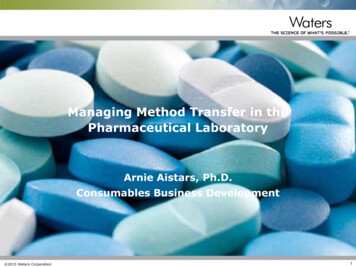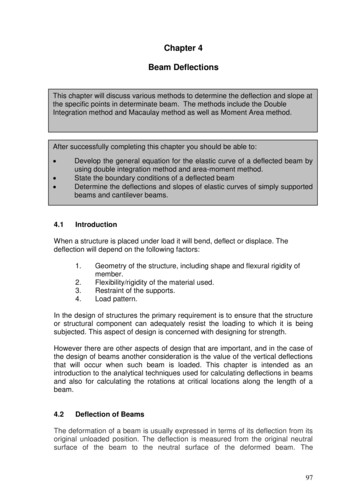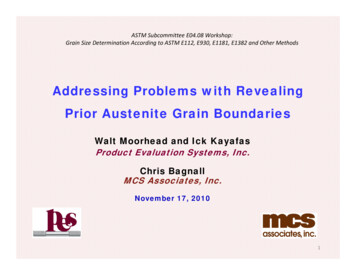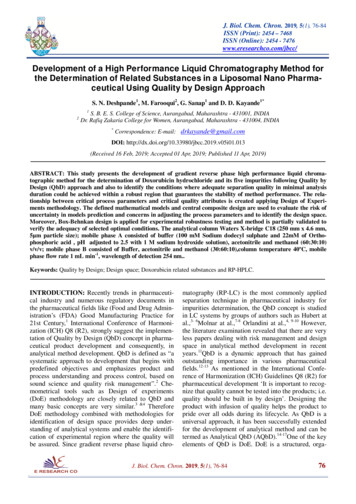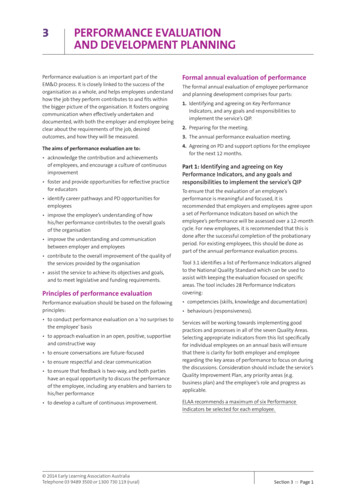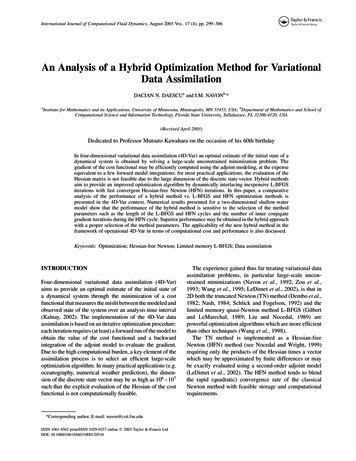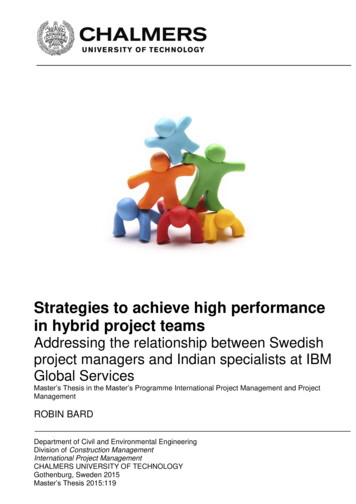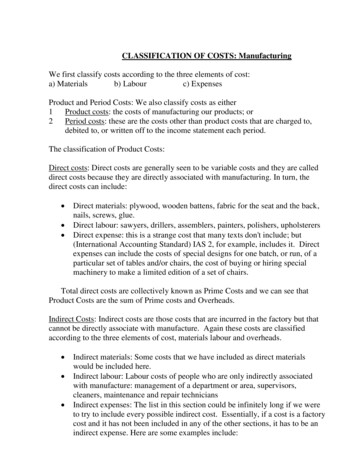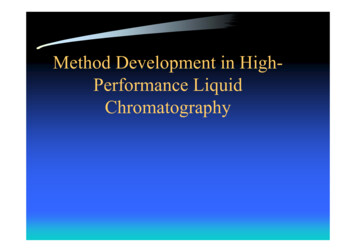
Transcription
Method Development in HighPerformance LiquidChromatography
The Chromatographic Process Diffusion in liquids is 100 times slower thandiffusion in gases. Therefore, in liquidchromatography it is not feasible to usecapillary columns – HPLC uses packedcolumns Small particles give high efficiency butrequire high pressure. Typical particle sizesin HPLC are 3-10 μm
Stronger solvent thanin (b)
Plate Height as a Function of FlowRate
Number of Theoretical Plates inHPLCUnder optimum conditions (near Hmin), the number oftheoretical plates in a column of length L is3500 L(cm )N d p (μm ) Small particles reduce eddy diffusion (A term) Small particles reduce the distance solute must diffuse inthe mobile phase (C term)
Smaller Particle Size Leads to Higher plate number Higher pressure Shorter run time (higher samplethroughput) Lower detection limit
Required Column PressureThe pressure required to drive the solvent througha column isu xη LP fπ r 2 d p2f – factor depending on particle shape and packingη – viscosity of the solventr – column radius
The Stationary Phase in HPLC The most common support – sphericalmicroporous silica particles permeable tosolvent. Silica dissolves above pH 8 andshould not be used above this pH (specialgrades are stable up to pH 9 or 10) For chromatography of basic compounds atpH 8-12, polymeric supports (polystyrene)can be used
Microporous Silica Particles50% porosity; S 150 m2/g70% porosity; S 300 m2/gNominal pore size is 10 nm
Schematic Structure of Silica GelUp to 8 μmol/m2 Si-OHProtonated at pH 2-3
Uses of Silica in HPLC Bare silica is used as the stationary phase inadsorption chromatography In liquid-liquid partition chromatography,the stationary phase is chemically bonded tothe silica surface
Bidentate C18 stationary phase stable in the pH range 2-11.5
Baseline separation of enantiomers of the drug Ritalin by HPLCwith a chiral stationary phase
Bulky isobutyl groups protect siloxane bonds from hydrolysis at low pH
Superficially Porous (Pellicular)Particles A stationary phase (e.g. C18) is bonded tothe thin, porous outer layer Mass transfer of solute is 10 times fasterthan into fully porous particles of the samediameter Especially suitable for separation ofmacromolecules (proteins), which diffusemore slowly than small molecules
Proteins separated on C18-silica. 1 – angiotensin II; 2 – neurotensin;3 – ribonuclease; 4- insulin; 5 – lysozyme; 6 – myoglobin; 7 – carbonicanhydrase; 8 - ovalbumin
The Elution Process In adsorption chromatography, solventmolecules compete with solute moleculesfor sites on the stationary phase Elution can be described as a displacementof solute from the stationary phase bysolvent
Eluotropic Series An eluotropic series ranks solvents by theirrelative abilities to displace solute from a givenadsorbent The eluent strength (ε ) is a measure of thesolvent adsorption energy, with the value forpentane defined as 0 on bare silica The more polar the solvent, the greater is its eluentstrength and the more rapidly will solutes beeluted from the column
Classification of HPLC Modes Normal-phase chromatography– Polar stationary phase– More polar solvent has higher eluent strength Reversed-phase chromatography– Nonpolar stationary phase– Less polar solvent has higher eluent strength
Elution Modes in HPLC Isocratic elution – performed with a singlesolvent or constant solvent mixture Gradient elution – continuous change ofsolvent composition to increase eluentstrength (analogous to temperatureprogramming in GC)
Example: Isocratic Separation ofAromatic Compounds by RP HPLCSolvent A – aqueous bufferSolvent B - acetonitrile
Gradient Elution of the SameMixture of Aromatic Compounds Same column, flow rate and solvents wereused
Selecting the Separation Mode
Suppose we have a mixture of small molecules soluble in CH2Cl2
“Green” Technology: SupercriticalFluid Chromatography
Phase diagram for CO2
Capillary SFC of aromatic compounds with CO2,using density gradient elution at 140 C
Effect of Sample Solvent The sample should be dissolved in a solventof lower eluent strength than the mobilephase or in the mobile phase itself
n-butylaniline
Method Development for ReversedPhase Separations Adequate resolution of desired analytes Short run time (high sample throughput) Rugged (not drastically affected by smallvariations in conditions)
Initial Steps in Method Development1. Determine goal2. Select method of sample preparation3. Choose detector
Criteria for an Adequate Separation Capacity factor 0.5 k’ 20Resolution Rs 2Operating pressure P 15 MPa (150 bar)0.9 asymmetry factor 1.5
Estimating Dead Time (Volume)Ld c2Vm 2Ld c2tm 2FF – flow rate (mL/min)dc2 – column diameter (cm)
dc 4.6 mm
Optimization with One OrganicSolvent Choice of organic solvent1. Acetonitrile (low viscosity, low UV cutoff)2. Methanol (higher viscosity and UV cutoff)3. Tetrahydrofuran (less usable UV range,slower equilibration with stationary phase)
Optimization with Two or ThreeOrganic Solvents Step 1 Optimize the separation withCH3CN/buffer (chromatogram A) Step 2 Optimize the separation withMeOH/buffer (chromatogram B) Step 3 Optimize the separation withTHF/buffer (chromatogram C)
Optimization with Two or ThreeOrganic Solvents (cont.) Step 4 Mix the solvents used in A, B, and C, onepair at a time, in 1:1 proportion (chromatogramsD, E, and F) Step 5 Construct a 1:1:1 mixture of the solventsfor A, B, and C (chromatogram G) Step 6 If some of the results A through G arealmost good enough, select the best two solventsand mix the solvents to obtain points betweenthose two
30% MeCN70% buffer40% MeOH60% buffer32% THF68% buffer
1 – benzyl alcohol2 – phenol3 – 3’,4’-dimethoxyacetophenone4 – m-dinitrobenzene5 – p-dinitrobenzene6 – o-dinitrobenzene7 – benzoin
Nomograph showing volume percentage of solvents havingthe same eluent strength
Temperature as a Variable Isocratic method development for HPLCcan use solvent composition, %B, andtemperature, T, as independent variables %B and T are each varied between selectedlow and high values From the appearance of chromatograms wecan select intermediate conditions toimprove the separation
Choosing a Stationary Phase
phenyl-silicaC18-silica
Order of Steps to Improve Separationof Two Closely Spaced Peaks1. Change the solvent strength by varying thefraction of each solvent2. Change the temperature3. Change the pH (in small steps)4. Use a different solvent5. Use a different kind of stationary phase
Gradient Elution Used in case of general elution problem (GEP) –mixtures of compounds with a wide range ofpolarities Run a broad gradient first to decide whether to useisocratic or gradient elution If Δt/tG 0.25, use gradient elution If Δt/tG 0.25, use isocratic elution Isocratic solvent should have composition appliedto column halfway through the period Δt
Gradient Elution (cont.)Δt – the difference in the retention timebetween the first and last peak in thechromatogramtG – the gradient time: the time over whichthe solvent composition is changed
Steps in Gradient MethodDevelopment1. Run a wide gradient (e.g., 5 to 100% B)over 40-60 min. From this run, decidewhether gradient or isocratic elution isbest2. If gradient elution is chosen, eliminateportions of the gradient prior to the firstpeak and following the last peak. Use thesame gradient time as in step 1
Steps in Gradient MethodDevelopment (cont.)3. If the separation in step 2 is acceptable, tryreducing the gradient time to reduce therun time4. If the separation is not acceptable, it canbe improved by going to a segmentedgradient
Method Development in High-Performance Liquid Chromatography. The Chromatographic Process Diffusion in liquids is 100 times slower than diffusion in gases. Therefore, in liquid chromatography it is not fea
